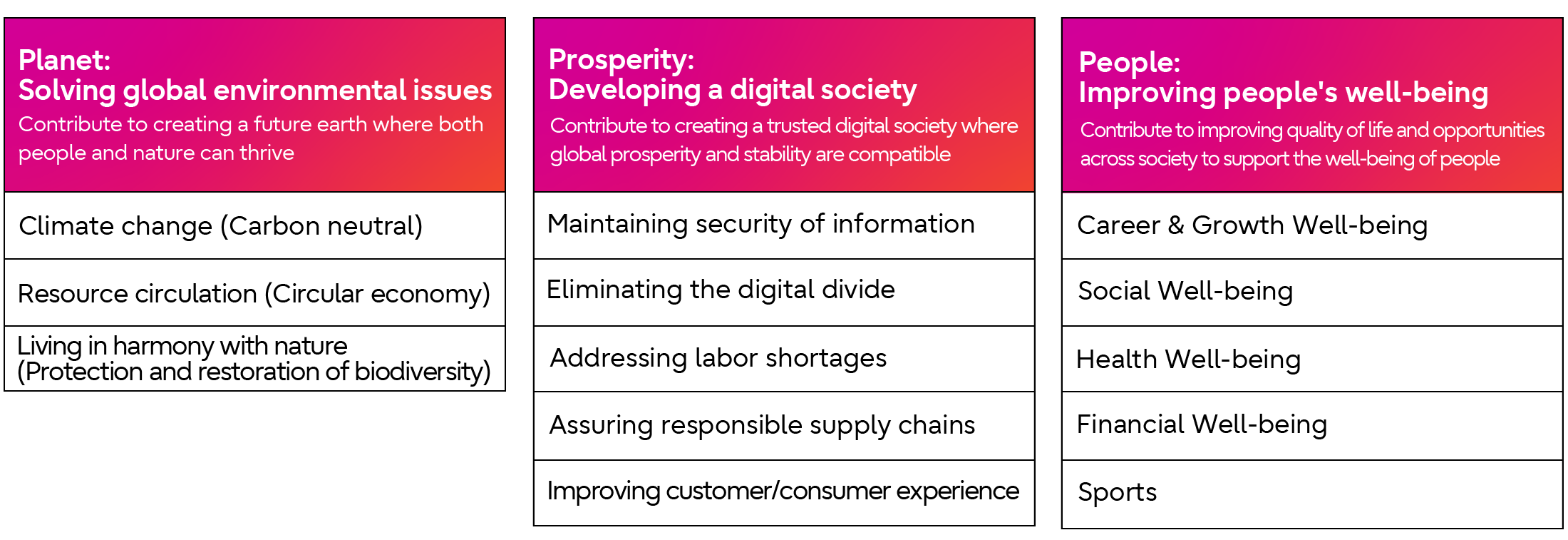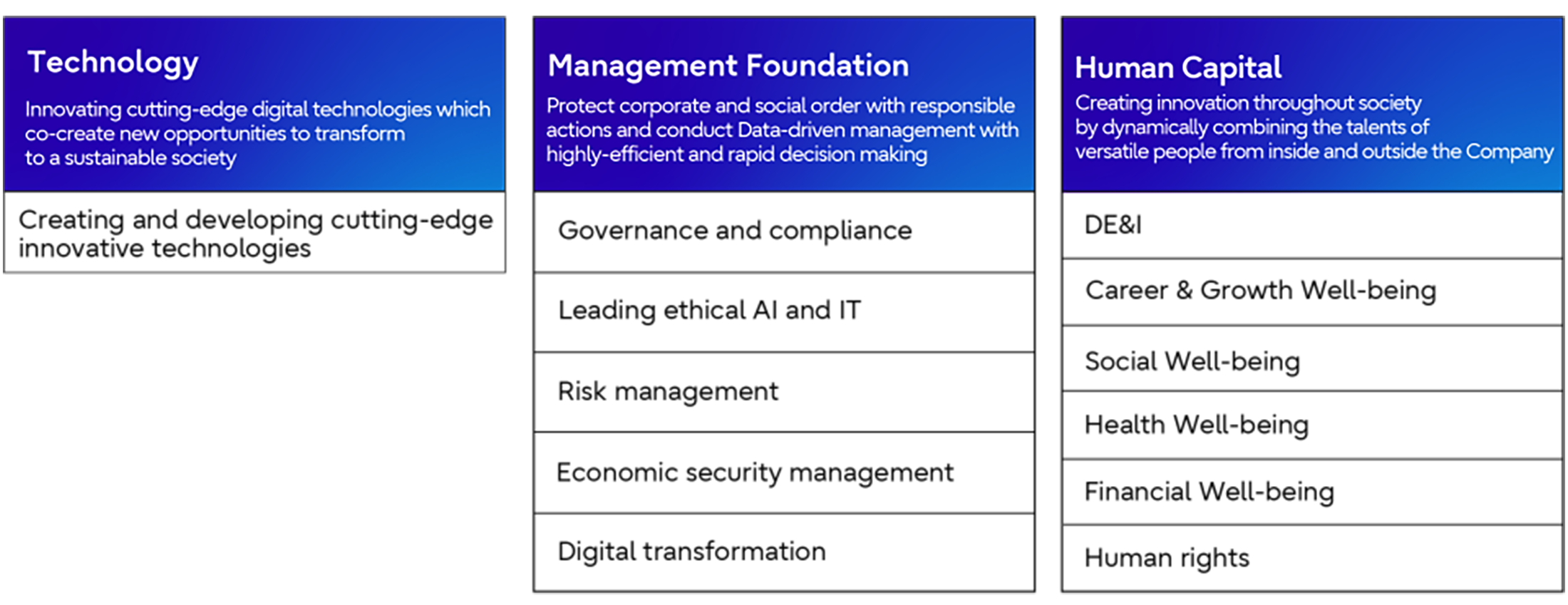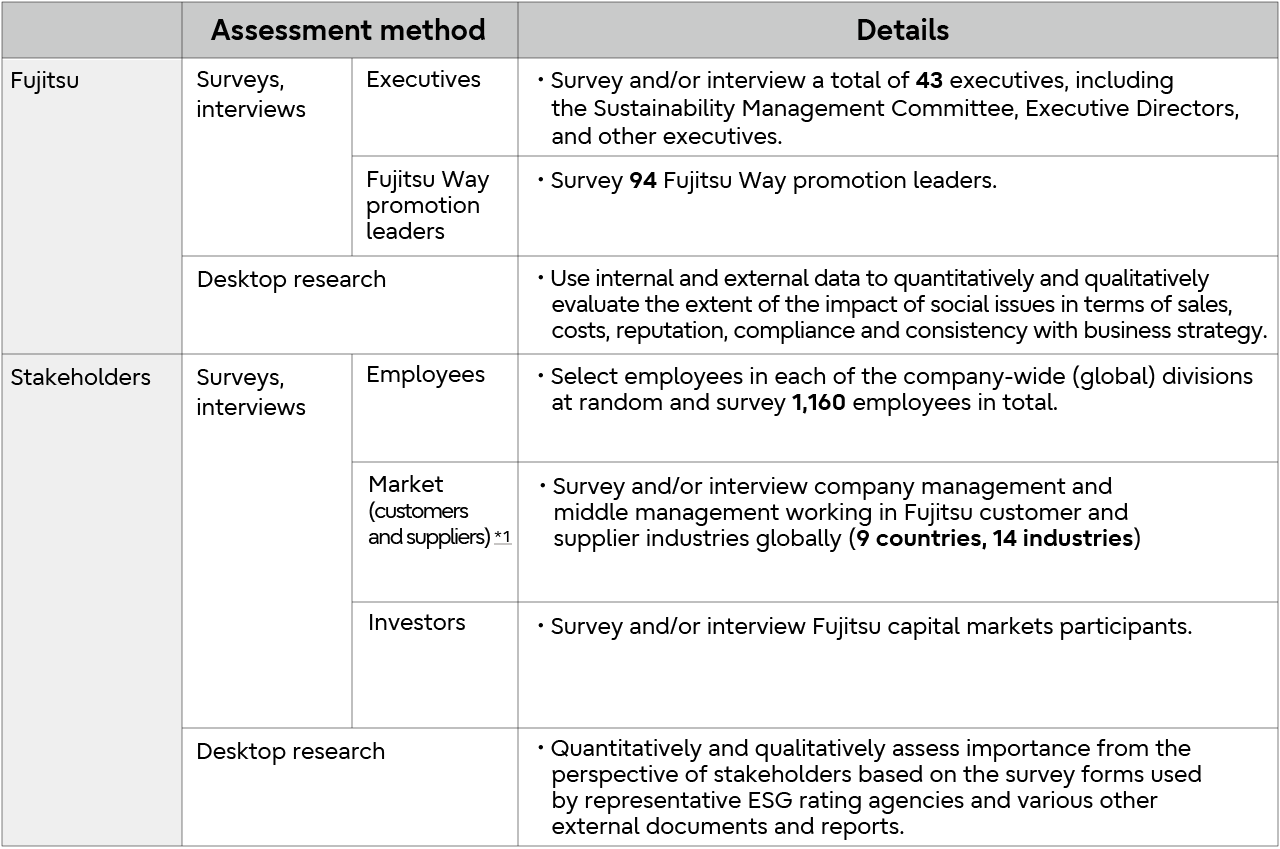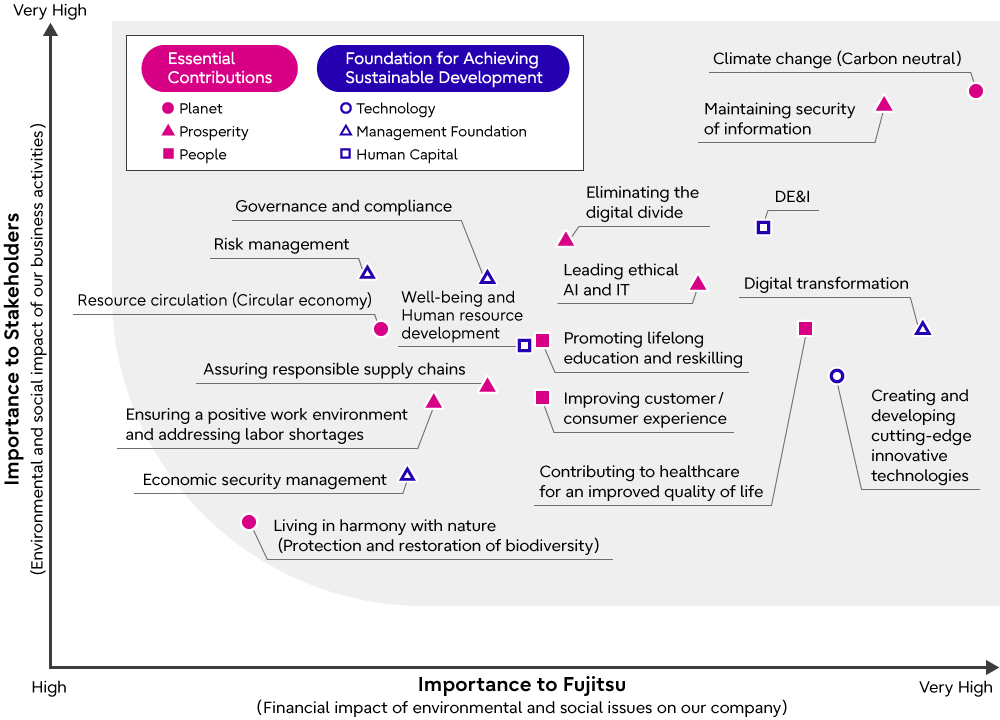Materiality
Materiality in the Fujitsu Group
The Fujitsu Group revised its approach to Materiality in 2023. We specified Materiality in 2018 under the Basic CSR Policy but have now updated it to encompass Materiality in Management, which incorporates the perspective of delivering value to customers and society through our business activities.
Looking ahead to 2030, we evaluated Materiality in terms of its importance to Fujitsu and its importance to stakeholders in the medium- to long-term, and identified two categories of key issues that must be resolved in order to achieve sustainable growth. The first category is ‘Areas of Essential contributions to sustainable growth’ and the second is ‘Fundamentals for achieving sustainable development.’ In the first category of Essential Contributions, we will leverage the development of Fujitsu Uvance and other businesses to provide customers and society with value that contributes to solving global environmental issues, developing a digital society, and improving people's well-being. Furthermore, we will strengthen our technology, management foundation, and human capital to create the Foundation for Achieving Sustainable Development as the source of value creation for the Fujitsu Group, while supporting the creation of new business models and spurring innovation.
In the fiscal year 2025, we reviewed some items of materiality from the perspectives of "Fujitsu-ness" and "value proposition," changing from 18 issues to 25 issues.
The results of the materiality assessment formulated in 2023 are also used for company-wide risk management. Issues such as climate change, human rights, and security identified through materiality analysis are linked as important risk items in potential risk assessments conducted throughout the Fujitsu Group, some of which are disclosed as "Business Risks."
And Materiality-related initiatives are recommended as a goal-setting item in the “Executive Performance Management” evaluation system for executives at FUJITSU VP-level and above. The non-financial indicators based on Materiality are being progressively linked to the evaluation indicators for executive remuneration (Executive Director bonuses).
Going forward, we will continue to promote company-wide initiatives related to Materiality, reduce and avoid critical management risks, and maximize business opportunities. In this way, we aim to enhance the corporate value of the Fujitsu Group and contribute to achieving net positives in the areas of environmental issues, digital society, and people's well-being.
Materiality

Essential contributions (3 global imperatives, with 13 issues where we will contribute in)

Foundation for achieving Sustainable Development (12 issues)

Materiality Assessment Process
The Fujitsu Group identified Materiality based on the principles of double materiality, whereby the mutual impacts of corporations and the environment and society are taken into account (i.e. both the financial impact of environmental and social issues on Fujitsu and the impact of Fujitsu business activities on the environment and society). We will conduct periodic reviews on an annual basis and revise as necessary.
Step 1 Organize and Identify Social Issues
-
Create a long list of various social issues (163 issues) that will flow from the future megatrends anticipated for 2030 based on the following:
- SDGs
- Evaluations of ESG indices (FTSE, MSCI and DJSI)
- ESG reporting framework (GRI Standards, SASB Standards)
- World Economic Forum (WEF) Global Risk Reports
- Responsible Business Alliance (RBA) Code of Conduct
- World Business Council for Sustainable Development (WBSCD), Global Enabling Sustainability Initiative (GeSI) documentation
- Identify 40 social issues by integrating similar items and deleting items with minimal business relevance
Step 2 Prioritization
- Conduct surveys, interviews and desktop research with a wide range of internal and external stakeholders based on the identified social issues. In anticipation of future circumstances in 2030, create a draft materiality matrix that prioritizes 25 social issues from 40 social issues in terms of the risks and opportunities those issues present. The draft materiality matrix is created by conducting comprehensive assessments and assigning scores to issues from the perspectives of their importance to Fujitsu (financial impact of the environmental and social issues on Fujitsu) and their importance to stakeholders (environmental and social impact of Fujitsu business activities).
- Leverage personal interviews and Sustainability Management Committee meetings to discuss and evaluate (ie, with reviews by executive directors, executive officers, non-executive directors and corporate auditors) the adequacy of the draft Materiality Matrix from the perspective of Fujitsu’s uniqueness (ie, affinity with the Fujitsu brand), and arrive at the final Materiality Matrix (condensed from 25 issues down to 18 issues).
- Organize the materiality concept and then classify and arrange the 18 issues into 2 categories and 6 areas.
Fujitsu and Stakeholder Assessment

*1: A commissioned study conducted by Forrester Consulting on behalf of Fujitsu, August 2022
Materiality Matrix (*2)

Step 3 Management Approval
- Go through the Sustainability Management Committee to discuss and approve Materiality as assessed, and the direction for promoting company-wide initiatives
- Materiality as included in the Medium-Term Management Plan is then discussed and approved by the Board of Directors.
Step 4 Review
- Annual review (*3)
- Discussions to be held at the time of mid-term management plan formulation.
*2: The names in this table are listed as determined in FY2023.
*3: A review was conducted by the Sustainability Management Committee in FY2024, resulting in a revision of some materiality items.
Approach to Materiality
Taking into account the risks and opportunities posed by materiality, we have discussed our approach for FY2025. Fujitsu will implement measures to address risks, focusing on our internal initiatives, while addressing opportunities by expanding Fujitsu Uvance and other businesses to solve social issues and provide value to customers and society. Moving forward with this approach to materiality will hasten reductions in the negative impacts while promoting greater positive impacts, leading to net positive outcomes for Fujitsu businesses and society.
Essential contribution
FY2025 Targets
- Customer NPS: +20 (Against a baseline of FY2022)
Contribute to global and regional communities
- Promote ongoing participation in community activities to boost employees’ level of engagement and improve their experience and perspective by helping to resolve social problems
- Expand partnerships that link us to future businesses and address social issues through community investment (including people, goods, and money) in NPOs, NGOs and regional communities
- Promote initiatives involving activities that make appropriate social contributions, through monitoring of impacts and the number of beneficiaries to identify the outcomes of activities
Planet: Solving global environmental issues -- Contribute to creating a future earth where both people and nature can thrive

FY2025 Targets
- GHG emissions Scope 1, 2: 50% reduction (against a baseline of FY2020)
- GHG emissions Scope 3, Category 11: 12.5% reduction (against a baseline of FY2020)
FY2030 Targets
-
Contribution to global GHG emissions reduction: 0.3% (Global CO2 reduction impact of Service Solutions business)
Please also refer to the Environmental Action Plan
Climate change (Carbon neutral)
Risks
・ Higher costs of coping with more stringent energy savings and GHG emissions regulations
・ Higher operating costs due to the increasing severity of natural disasters
Opportunities
・ Increased demand for the adoption of renewable energy, energy savings and visualization of GHG emissions, including in supply chains
・ Increased demand for mitigation measures that offer society-wide energy optimization to reduce GHG emissions and for adaptation measures that build resilient communities and industries
Internal initiatives
・ Reduce GHG emissions at business sites (promote energy savings and increase renewable energy use)
・ Promote energy-saving product design and reduce GHG emissions in the supply chain
Business growth for customers and society
・ Visualize/reduce GHG emissions in the supply chain
・ Visualize energy usage at factories and other facilities (automate primary data collection)
・ Identify a broad spectrum of supply chain risks, including disasters, pandemics, and international political risks
・ Develop and make effective use of new energy sources and materials, such as clean ammonia, and improve traceability
・ Optimize and integrate natural energy into social infrastructure systems
・ Enhance resilience against emergencies in cities
・ More accurate weather forecasts and disaster prevention simulations
Resource circulation (Circular economy)
Risks
・ Increased costs for operations and for handling the reputational risk arising from resource constraints resulting from resource depletion and escalating conflicts over scarce resources resulting from resource maldistribution
Opportunities
・ Increased demand for support to create a circular (recycling-based) society by building economic mechanisms that will sustainably recycle resources and promote zero waste and the effective use of resources
Internal initiatives
・ Reduce water usage at business facilities and raise awareness of water source security upstream of the supply chain
・ Promote greater resource savings in products and improved resource circulation
・ Get involved in activities to standardize business models and circular economy indicators, and measure social impacts
Business growth for customers and society
・ Reduce losses and enhance traceability through the use of blockchain
・ Promote the effective use of materials through the visualization of product quality, etc.
・ Enhance resource traceability with the aim of creating environmental value through recycling
・ Establish recycling schemes and assure a stable supply of recycled resources though business-to-business data sharing
Living in harmony with nature (Protection and restoration of biodiversity)
Risks
・ Amid increasingly strict controls on land use and information disclosure, there is increased reputational risk and the risk of difficulty in raising capital due to delays in addressing biodiversity
Opportunities
・ Increased demand for assessing, visualizing, monitoring, and reducing impact on the environment and biodiversity, and urban development that co-exists with nature
Internal initiatives
・ Reduce negative impacts and increase positive impacts on biodiversity in areas of business activities, including the supply chain
Business growth for customers and society
・ In business activities that take biodiversity into account, use business planning simulations to visualize environment conservation and impact severity
・ Protect water and forestry resources and limit excessive consumption by developing new materials and adopting new production methods
Business Impacts
- Promoting activities that minimize environmental impacts in our areas of business activity, including the supply chain (reducing GHG emissions, saving and recycling resources, protecting biodiversity) can help to reduce or avoid risks such as reputational damage and excessively strict regulatory controls
- With the transition to a more environmentally friendly society, there is increasing demand for minimization of the environmental impacts on each industry’s entire value chain. Expanding businesses that are designed to address environmental issues and create value for the environment can lead to increased financial returns
See TCFD Information Disclosure for more information on the analysis of business impacts from climate change
Societal Impacts
- By developing solutions such as using digital technology to visualize environmental footprints and improve traceability, we can contribute to restoring biodiversity, building a circular economy and a carbon-neutral society, as well as reducing our customers’ environmental impacts
Prosperity: Developing a digital society -- Contribute to creating a trusted digital society where global prosperity and stability are compatible

FY2030 Targets
-
Digital accessibility: 150 million people
Contributing to the improvement of digital accessibility in society by providing Fujitsu services and developing various activities
(Based on the number of Fujitsu Uvance solutions provided, investee services/solutions, and community activities, the actual number of people influenced by digital accessibility improvement is grasped. Monitoring and management are promoted.)
Maintaining security of information
Risks
・ Amid increasingly strict regulatory regimes, risks include loss of credibility, fines and penalties for violations of laws and regulations if the rights and interests of individuals are violated or customer information is leaked due to leakage of information related to business activities
Opportunities
・ Increased demand for more advanced information infrastructure that is trusted and secure with the aim of providing data security at the society, corporate and individual levels
Internal initiatives
・ Stronger governance: Implement countermeasures more quickly and effectively by bolstering on-site security systems and active intervention by management
・ Stronger responses to cyber threats: Use more rigorous information management and responses, and security risk visualization that includes prediction
・ Stronger supply chain security: Consolidate data in secure development environments and data management environments, and develop training to achieve more mature security
Business growth for customers and society
・ Ensure that customer systems and businesses are trusted by providing secure Hybrid IT platforms
・ Provide resilient Hybrid IT platforms along with more rigorous IT and security governance for mission-critical areas such as public-sector and financial institutions
・ Enable security management that is capable of responding quickly to stricter and more sweeping regulations, such as the Data Protection Directive
・ Combine Zero Trust Security technology and other technologies to create a new high-speed, high-capacity network security technology that offers enhanced reliability and convenience
Eliminating the digital divide
Opportunities
・ Increased adoption of “digital democratization” whereby anyone can independently, freely and autonomously use digital technology, leading to increased demand for digital platforms that do not encourage discrimination, prejudice or hate
Business growth for customers and society
・ Optimization tailored to patients and the democratization of advanced healthcare
・ Enable more advanced decision-making and problem solving for the traceability and verification of raw materials
・ Promote the adoption of integration and corporate IT consulting through co-creation with financial institutions
・ Build broadband networks for local governments (US)
Addressing labor shortages
Opportunities
・ Increased demand for productivity and quality improvements, automation and streamlining to address labor shortages
Business growth for customers and society
・ Provide ways to make work (production, distribution, shipping, sales, etc.) both safer and more efficient by using automation technology, AR/VR, and remote communication
・ Make operations more efficient and advanced using digital technology, and plan the optimal workspace for customers’ business transformation
・ Provide high-usability services by using more advanced digital touchpoints with automated technology, multilingual support, and AIOps
Assuring responsible supply chains
Risks
・ If problems arise in the supply chain, such as human rights violations involving conflict minerals or the working environment, or damage due to environmental destruction or climate change, these problems pose risks such as impacts on continued business activity, erosion of social trust in the company following administrative penalties, and lost business opportunities
Opportunities
・ Increased demand for the building of platforms and the enhancement of information disclosure, optimization and visualization of supply chain management in the environmental and social areas, particularly with regard to the environment, human rights and mineral resources (procurement)
Internal initiatives (approach to the supply chain)
・ Prevent and reduce human rights risks in the supply chain
・ Promote reduction of GHG emissions in the supply chain
・ Ensure supply chain diversity
Business growth for customers and society
・ Provide stronger management through improved supply chain traceability
・ Enable detection of a broad spectrum of supply chain risks, including disasters, pandemics, and international political risks
・ Enable digitalization and resilience in supply chains that are shared by multiple corporations on a global scale
・ Enable sustainable consumption and waste reduction through end-to-end value chain optimization
・ Offer logistics optimization and retail (OMO) management
・ Enable digital tracking of products along the supply chain
・ Enable new value creation/conversion using secure platforms that support expanded ethical purchasing
Improving customer/consumer experience
Opportunities
・ Improvements in peoples’ attitudes towards new consumption, new relationships and new work styles as their values become more diverse. Greater demand for personalized consumer experiences and the creation of new ways to exchange personal, corporate and social values.
Business growth for customers and society
・ Personalize marketing and promotion, and enable new online and offline purchasing
・ Improvements in peoples’ attitudes towards new consumption, new relationships and new work styles as their values become more diverse. Greater demand for personalized consumer experiences and the creation of new ways to exchange personal, corporate and social values.
・ Provide efficient monitoring, operation, and maintenance for retail systems
・ Enable sophisticated promotions that target consumers by predicting their behavior
Business Impacts
- While issues such as inadequate information security measures and human rights violations in supply chains can lead to loss of customer and public trust as well as escalation in the cost of dealing with such issues, these risks can be minimized by establishing strong governance structures and introducing effective countermeasures
-
Our customers and society also face the above issues, as well as problems such as a growing digital divide and worsening labor shortages. With the transition to a digital society, developing businesses aimed at resolving these issues can help to increase our financial returns
Societal Impacts
- By developing solutions such as explainable AI and secure information infrastructure, we can build trusted digital technology into society and help to build a more resilient society where more people can reap the rewards of digital technology
People: Improving people’s well-being -- Contribute to improving quality of life and opportunities across society to support the well-being of people

FY2030 Targets
-
Provision of ICT skills and education: In excess of 12 million people
Contributing to the improvement of ICT skills and expansion of education in society by providing Fujitsu services and developing various activities
(Based on the number of Fujitsu Uvance solutions provided, services/solutions of the investee, community activities, events and study groups, the actual number of people influenced by ICT skills improvement is grasped. Monitoring and management are promoted.)
Career & Growth Well-being
Opportunities
・ Increased demand for initiatives that allow people to live rich and fulfilling lives, such as the building of digital education platforms that enable people to learn freely at any time and to have their achievements evaluated appropriately
Business growth for customers and society
・ Provide micro-learning environments that use AI to provide personally optimized education, regardless of time or location
・ Enable strategic reskilling by defining the ideal candidate personas for DX implementation, supporting the establishment of talent resource strategies and talent development plans, and providing education and training programs
Social Well-being
Opportunities
・ Creation of a comfortable, safe, and secure work environment that results in higher employee motivation
Business growth for customers and society
・ Plan and execute strategies in response to changes in the work environment by visualizing business conditions and analyzing employee opinions in order to effect reform of work styles and improve engagement, with emphasis on workers
Health Well-being
Opportunities
・ Increased demand in communities for healthcare that is integrated into daily life, such as the digitalization of medicine and preventive healthcare that uses AI and the IoT
Business growth for customers and society
・ Connect medical institutions with external institutions and services to enable the mutual exchange of consumers’ and patients’ treatment and lifestyle information
・ Individualize and optimize a patient's end-to-end healthcare journey, from prevention through to treatment and recuperation (effective personal healthcare)
Financial Well-being
Opportunities
・ Greater employee engagement and economic stability through appropriate and fair remuneration
Business growth for customers and society
-
Sports
Opportunities
・ In addition to collaborating with local communities, increasing employee engagement, and elevating our corporate image through sport (an area that sets Fujitsu apart), we are also contributing to business by creating opportunities for collaboration with customers
Business growth for customers and society
・ Provide a data analysis platform that digitizes human movement using high-precision skeleton analysis technology
Business Impacts
- As core values shift from material wealth to spiritual richness, people will demand more advanced medical treatments, healthcare, and education. This will give rise to human-centric businesses that support safe, secure, high-quality lifestyles, which will in turn lead to greater financial returns.
Societal Impacts
- By providing services that cater to people’s individual healthcare needs and respond to consumption trends while providing them with the upskilling they need for their career plans, we can not only help people live longer, healthier lives, but we can also help build a society where everyone lives a full and happy life where they can maximize their own potential
Foundation for Achieving Sustainable Development
FY2025 Targets
・ Per capita productivity: +40% (against a baseline of FY2022)
Technology: Innovating cutting-edge digital technologies which co-create new opportunities to transform to a sustainable society

Creating and developing cutting-edge innovative technologies
Risks
・ R&D into cutting-edge technology is the wellspring of corporate growth. If technology development does not progress, it will lead to the risk of losing competitiveness
・ Digital innovation that supports DX/SX is essential for business transformation and a sustainable society
Internal initiatives
・ Quantum: Work with customers to develop apps that use quantum-HPC hybrid technology and develop world-leading error-correction technology. Develop 1,000 qubit machines and further scaling technologies
・ Computing: Enhance computing workload broker technology, develop frameworks that will accelerate graph AI and expand HPC into new areas such as digital twins
・ AI: Provide global customer value through AI platforms that feature AI technology, such as world-leading graph AI and AI trust. Strategically acquire specialists in the AI area.
・ Data & Security: Accelerate innovation-creation using ecosystems with world-leading Web3/Trust technology that allows the distribution and use of highly reliable distributed data maintained by companies or individuals
・ Converging Technologies: Develop the world’s first Social Digital Twin Platform to continually improve society by devising initiatives that leverage environmental, social, and economic synergies, thus enabling Sustainability Transformation (SX) solutions that can be rolled out globally
Business Impacts
- Helping to achieve sustainable business innovation by conducting R&D into the 5 technology areas of Computing, AI, Data & Security, Converging Technologies and Networks and creating digital innovation
Societal Impacts
- Continue to help resolve customer and societal issues and support Sustainability Transformation (SX) by providing all-inclusive value, enabled through a combination of technologies
Management Foundation: Protect corporate and social order with responsible actions and conduct Data-driven management with highly efficient and rapid decision-making

Governance and compliance
Risks
・If a strong governance structure is not maintained, and disclosure and oversight of execution are not enhanced, there is a risk of undermining sound management
・Situations that violate national or international laws or regulations risk exposure to surcharges or financial compensation, and erode public trust
Internal initiatives
・ Corporate governance:
・ Undertake continual reviews of corporate governance
・ Fully disclose corporate information that is conducive to cooperative relations with all stakeholders, including shareholders
・ Promote constructive interaction with shareholders
・ Compliance:
・ Promote the Global Compliance Program to raise awareness of compliance
・ Provide compliance training to suppliers
Leading ethical AI and IT
Risks
・ Ethical or other issues that originate from data or other input to an AI pose the risk of problems such as diminished social trust or litigation
・ If employees and customers lack understanding of or experience in implementing AI ethics, this could pose the risk of eroding trust in AI and inhibiting the innovation and progress that is possible using AI
Opportunities
・ Implement initiatives aimed at disseminating AI ethics, such as providing AI ethics training to employees and customers, and formalizing the Fujitsu internal practice of AI ethics
Internal initiatives
・ Implement initiatives aimed at disseminating AI ethics, such as providing AI ethics training to employees and customers, and formalizing the Fujitsu internal practice of AI ethics
・ Provide technology and ecosystems that simplify the identification of AI ethics risk by AI developers and customers themselves, and present solutions
Business growth for customers and society
・ Implement initiatives aimed at disseminating AI ethics, such as providing AI ethics training to employees and customers, and formalizing the Fujitsu internal practice of AI ethics
・ Implement initiatives aimed at disseminating AI ethics, such as providing AI ethics training to employees and customers, and formalizing the Fujitsu internal practice of AI ethics
Risk management
Risks
・ The absence of a strong risk management can have an impact on the company’s business continuity
Internal initiatives
・ Conduct internal assessment reviews using tools to measure potential risk, visualize the impacts of those risks using actualized data, and formulate and implement recurrence-prevention measures
・ Build data-driven risk management systems
・ Build a global solutions network to ensure that overseas risk information is reported to and acted upon by the Head Office promptly
Economic security management
Risks
・ Given the current global instability and the trend towards stronger regulation of corporate activity in the interests of maintaining economic security, there are risks in the form of impacts on supply chains and markets targeted by companies, together with burdens such as the increased costs of responding to such impacts and financial penalties for companies found to have breached the regulations
Internal initiatives
・ Bolster business resilience by assessing risks to business continuity from the perspective of economic security and geopolitics, and then reflect those risks in the business continuity plan (BCP)
・ Strengthen Companywide management across all departments for technologies that include important cutting-edge fields
・ Respond to the economic security countermeasures in each country and region
Digital transformation (DX)
Risks
・ Failure to achieve digital transformation risks declines in productivity and delayed responses to the external environment, which can adversely affect our competitiveness
Internal initiatives
・ Expand data-driven management and operational excellence by promoting the OneFujitsu Program:
・ Real-time management to support speedy and practical decision-making
・ End-to-end management resource visualization and conversion to digital data
・ Global standardization of business processes
Business Impacts
- Failure to maintain a strong management infrastructure and improved management efficiency poses serious risks such as lower productivity and lower levels of social trust
-
Establishing robust governance structures and introducing effective countermeasures can help to minimize such risks
Societal Impacts
- Failing to maintain a strong management infrastructure and improved management efficiency could also result in losses for customers and suppliers in the business area. Establishing robust governance structures and introducing effective countermeasures can help to minimize these risks
Human Capital: Creating innovation everywhere in society by bringing together agile and versatile people from inside & outside the Company

FY2025 Targets
- Employee engagement : 75
- Diversity in Leadership (ratio of women in leadership roles): 20%
DE&I
Risks
・ Disrespect for or insufficient consideration of diversity in stakeholders such as employees or people in the supply chain poses a wide range of risks, including loss of business opportunities, erosion of social trust in the company following administrative penalties and loss of personnel
Internal initiatives
Diversity:
・ Build an inclusive and egalitarian corporate culture that makes everyone feel included and free to express themselves
・ Boost the participation of women in leadership positions
・ Develop a comprehensive strategy for cultures and ethnicities that operates globally
・ Introduce the FWEI (Fujitsu Workplace Equality Index)
・ Promote and advocate for digital accessibility as one corporate strategy, including in-brand communication, customer experience, and the workplace
・ Ensure supply chain diversity through:
・ Activities to determine diversity indicators based on the societal requirements in each country or region
・ Development of mechanisms to determine the support for female participation in key activities in the domestic supply chain and to measure the progress of initiatives by suppliers
Career & Growth Well-being
Risks
・ Failure to provide opportunities for employees to achieve personal growth poses risks including losing key talent and eroding the brand value
Internal initiatives
・ Develop an environment that encourages each individual to proactively take on challenges and grow
・ Raise career awareness and provide opportunities for individuals to focus attention on their careers whenever a turning point presents itself in life or career
・ Support growth through daily communication with management and team members
Social Well-Being
Risks
・ Failure to provide a satisfying work environment by building and maintaining good, trusting relationships between employees poses risks including losing key talent and eroding the brand value
Internal initiatives
・ Improve productivity and creativity and create new value by implementing hybrid work that combines real and virtual working arrangements according to business objectives
・ Create an organizational environment where employees are connected by mutual trust and are able to take on new challenges
・ Establish an environment that facilitates communication across the organization and beyond
Health Well-Being
Risks
・ Failure to provide an environment where employees can work safely and energetically while staying healthy physically and mentally poses risks including losing key talent and eroding brand value
Internal initiatives
・ Increase awareness among employees to take responsibility for managing their own health
・ Promote behavioral change by increasing health literacy among individuals and throughout the organization via a wide range of health education, health events, and health apps
・ Establish an in-house system whereby occupational health staff provide meticulous physical and mental health support for employees, from disease prevention to promotion of good health, through individual consultations and referrals to specialists
・ Analyze health data and share whole-of-organization health issues, using this to propose and implement health programs to support workplace improvements at senior management level and thereby improve the overall health of the organization
・ Provide thorough health and safety compliance measures and safeguards
・ Provide educational opportunities and occupational safety and health information to raise awareness of preventing workplace accidents and achieving zero serious workplace accidents
Financial Well-being
Risks
・ Failure to provide appropriate and fair remuneration to employees to boost their engagement and provide economic stability poses risks including losing key talent and eroding brand value
Internal initiatives
・ Set appropriate remuneration levels based on market standards (global). For some highly specialized job types, introduce and implement a flexible and attractive system for handling these individually.
・ Raise employee awareness of asset building through remuneration systems and wealth accumulation policies
・ Expand learning environments with the aim of improving financial literacy
Human rights
Risks
・ Human rights violations among employees, supply chains and other stakeholders poses multiple risks, including loss of business opportunities, erosion of public trust in a company if administrative penalties are imposed, and loss of key talent
Internal initiatives
・ Implement ongoing human rights education
・ Hold Stakeholder Dialogue sessions
・ Work with our partners, customers and NGOs, using Fujitsu’s expertise and technologies to help promote and protect respect for human rights
Business Impacts
- Boosting investment in human capital, such as through stronger personnel development platforms and personnel portfolios, can assist in extracting the maximum possible value from personnel and increase sustainable value creation and corporate value
Societal Impacts
- Promoting activities to protect diversity and respect for human rights in the supply chain can help to lessen or avoid DE&I-related supply chain risk
*4: Recognition of risks & opportunities was organized and analyzed based on various publicly available information in Step 1 (Organize and Identify Social Issues) of the materiality assessment process.


